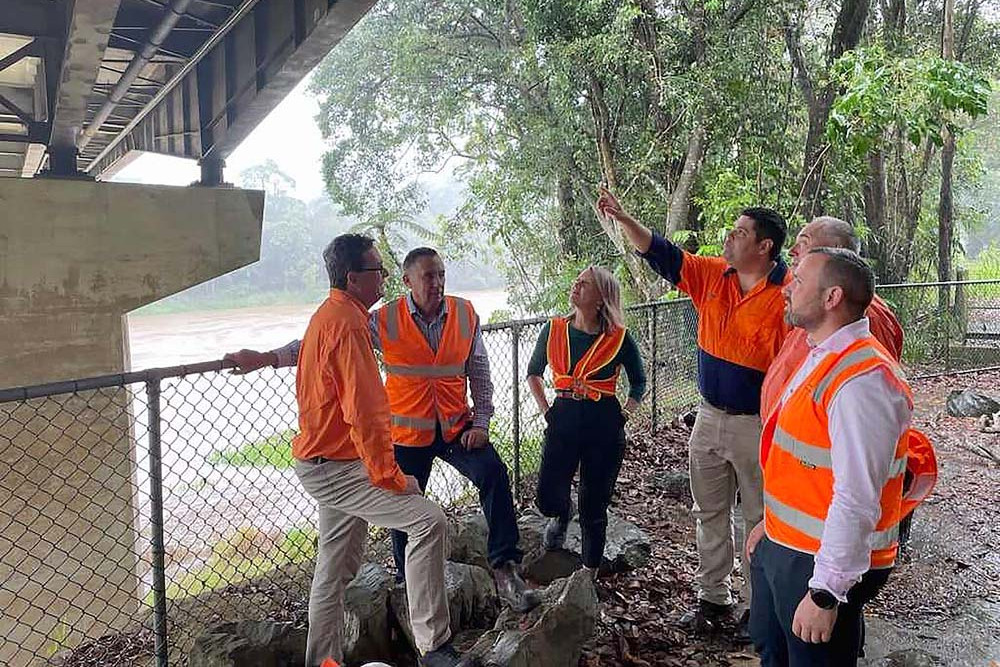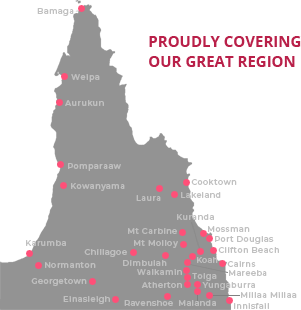Community & Business
11 December, 2024
Minister visit signals top priority to fix road, bridge
JUST a few weeks after being sworn in, Minister for Transport Brent Mickelberg has made it a priority to travel to our region to inspect the Barron River bridge at Kuranda and the problematic range road.

Dressed in high-vis workwear, Mr Mickelberg sat down with The Express last week to talk about both road network problems, revealing he is fully aware of how important the route is to people living in the Mareeba Shire and on the Tablelands because he has previously done the commute to Cairns himself while living at Atherton.
During his visit, Mr Mickelberg had a briefing with Main Roads officers about the state of the bridge and said he was satisfied that it was safe to use but would need regular one-lane closures to allow for maintenance to be undertaken to keep it safe and retain the current 42.5 tone load limit.
“We will build a new bridge and we will build it quicker than seven years (the previous government’s timeline),” he said, although he could not yet commit to a timeline.
His lived experience of the uncertainty that the range road will close at any time during the wet season due to fallen trees, rocks, landslides or accidents helps him understand and recognise the importance of having a road that is reliable.
“So, I used to live in Atherton and then Trinity Beach, travelling back and forth for a few years – the main thing you want is to know you can make it to an appointment in Cairns and get back home again,” he said.
Mr Mickelberg said he understood why the community had lost trust in the department, in part due to assertions by the public that the installation of the Intelligent Transport System (ITS) had undermined the foundation of the road, causing two massive landslips – a claim the department has rejected.
“I think the starting point is that we have to be open and transparent with the community, so it’s one of the reasons this visit is a priority, because it’s a massive community concern,” he said.
“It’s going to be complicated (to fix the bridge and road) but I think community concern is only exacerbated when you try to spin a narrative or ignore them.
“I’m aware of the concerns and asked those questions since I’ve been appointed, but I must say I’ve been pretty impressed with the level of professionalism and commitment (of the department).
“I don’t think the department is the problem in that relationship – the fact the community hasn’t felt like they’ve had a voice or been listened to in recent times is, in my mind, the principal problem.
“Bree (James) and David (Kempton) asked me to come up here as a priority because we know there is genuine community concern – there’s genuine issues as well which are going to take a while to work through but we need to work through them because if we don’t provide a reliable road, then people are going to continue to be dissatisfied.”
He agreed the road was the constraint in allowing the region to reach its full potential.
“Ultimately, everyone understands that the road needs to be more reliable – when I talk about reliable, that people can have the confidence to get where they need to get and home, but the other part is having confidence that the road can meet demand,” Mr Mickelberg said.
He thinks the ITS has its benefits, because the cameras allow RoadTek to see areas of the road and respond to issues, and the speed signage alerts motorists to slow down when the road is treacherous.
“The next part is that if the Kuranda range is closed and I’m coming from Mareeba, then I’d like to know that at Mareeba so how do we then make sure that information is passed onto the community,” he said.
“Those sorts of things are quick wins but there’s also the maintenance question – being able to get in front of the maintenance to ensure that trees don’t unnecessarily fall over into the road for example.”
Mr Mickelberg said the recovery works to the range were complex and difficult, revealing that even the supply of materials required to repair the significant slips was a challenge.
“We will have to use 55km of reinforcing metal rods as part of the stabilisation works – to put that into perspective, we will be using twice the amount of rods in this project alone that is used in the whole of Australia per year,” he said.
In terms of an alternative road in the future, Mr Mickelberg said the cost and timeframe a new route would require was leading him to believe that making the current corridor robust and reliable may be the most realistic option.
“What we have there right now is not coping – the reliability of the bridge and the road is not where it needs to be so it’s clear we need investment – I have asked for information on the alternative routes but they have as many challenges – the best solution may be investing in the existing crossing but it needs to be reliable and it needs to be safe,” he said.


